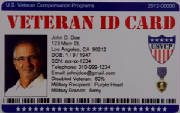|
|
|
|
|
|
Did You Know?
HR 1331 The Quicker Veterans Benefits Delivery Act of 2015 – H.R. 1331 – was introduced in the House of Representatives on March 4, 2015, by Representative Timothy J. Walz of Minnesota. The purpose of this bill is to improve the treatment of medical evidence provided by non-Department of Veterans Affairs medical professionals in support of claims for disability compensation under the laws administered by the Secretary of Veterans Affairs, and for other purposes, an amendment to section 5125 of Title 38 United States Code – Veterans Benefits. Approval of this bill would enable veterans to be seen by private doctors in their local area in a timely manner instead of waiting on a Department of Veterans Affairs approved doctor to conduct medical evaluation for disability compensation and treatment. This would also include treatment of mental health disorders.
Veterans Ride for Free In the latest effort to help veterans find work and offer better travel solutions to and from their VA health care facilities, Sun Metro introduced a temporary pilot program that offers free bus rides to veterans seeking employment or health care. Veterans can apply at Project Amistad or at Sun Metro. They will need to show a valid form of I.D. with their veteran status, such as a military ID, VA medical ID card, Veteran ID Card, veteran designation on a driver’s license, or certificate of release or discharge from active duty.
Understanding What It Means to Be Rated 100% Disabled
Unfortunately, many veterans are too often confused about Department of Veterans Affairs (VA) 100 percent disability ratings and whether or not they are allowed to secure gainful employment if rated at 100 percent. While complex, and sometimes confusing to the most experienced VSO, let’s take a look at the four types of 100 percent disability ratings in plain, understandable English.
1. Combined. When a veteran's service-connected disabilities are combined to reach 100 percent, he/she is allowed to work full time or part time. For example, if a veteran is rated 70% for PTSD, and 30% for IBS, the two disabilities equal 100% (sometimes – see rating table), and the veteran is allowed to hold a full time or part time job.
2. TDIU or IU. Total Disability/Individual Unemployability. This is a specific type of claim made by a veteran, requesting that he/she be paid at the 100 percent rate even though his/her disabilities do not combine to reach 100%. The request is often made because the veteran is unable to maintain "gainful employment" because his/her service-connected disabilities prevent him/her from doing so. The basic eligibility to file for Individual Unemployability (IU) is that the veteran has one disability rated at 60 percent or one at 40 percent and enough other disabilities that result in a combined rating of 70 percent or more. The one disability at 40 percent criteria can be a combined rating of related disabilities. Meeting the basic criteria is not a guarantee that the veteran will be awarded 100 percent under IU criteria. The medical evidence must show that the veteran is unable to work in both a physical and sedentary job setting. A veteran not meeting the percentage criteria may still be awarded IU if the disabilities present a unique barrier to gainful employment. If a veteran is granted 100 percent under IU he is prohibited from working full-time, because in filing the claim for IU the veteran is stating he/she is unable to work because of his/her service-connected disabilities. However, receiving IU does not necessarily prevent a veteran from all employment circumstances. The veteran can work in a part-time "marginal" employment position and earn up to a certain amount annually, but not allowed to surpass a certain amount.
3. Temporary 100 percent rating. If a veteran is hospitalized 21 days or longer or had surgery for a service-connected disability that requires at least a 30-day convalescence period, the VA will pay at the 100 percent rate for the duration of the hospital stay or the convalescence period. For example, if a veteran has a total hip replacement for a service-connected hip disability, the VA will pay 100 percent compensation for up to 13 months, the standard recovery period for a replacement of a major joint. The duration of 100 percent temporary disability for any other type of surgery will depend on what the doctor reports as the recovery period.
4. Permanent and total. A 100 percent "permanent and total" rating is when the VA acknowledges that the service-connected conditions have no likelihood of improvement and the veteran will remain at 100 percent permanently with no future examinations. The P&T rating provides additional benefits, such as Chapter 35 education benefits for dependents, among others. Veterans sometimes make the mistake of requesting a P&T rating simply because they want education benefits for their dependents. The one caveat that veterans need to keep in mind is that when P&T is requested, all of their service-connected disabilities will be re-evaluated. If improvement is noted during the subsequent examinations, a reduction from 100 percent can possibly be proposed. Because many veterans are service-connected for conditions that VA says have a "likelihood of improvement," most ratings are not considered permanent and are subject to future review. The only time veterans can't work a full-time position, that is considered a gainfully-employed job is if they were awarded 100 percent disability through a claim for IU. Additionally, a 100 percent rating under either IU or combined ratings may or may not be rated as permanent and total. A temporary 100 percent rating is just that: temporary due to being hospitalized or recovering from surgery on a service-connected condition.
Keep in mind, it is always best for a veteran to work with an accredited Veteran Service Officer (VSO) who can explain the complex workings of the VA benefit system. |
|
|
|
|
|
|

